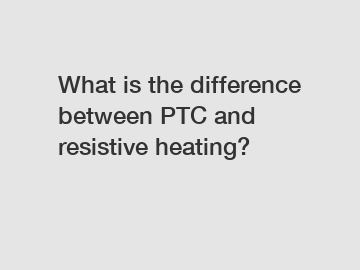What is the difference between PTC and resistive heating?
What is the Difference between PTC and Resistive Heating?
Heating is an essential requirement in various industries and households. Two commonly used heating methods are PTC heating and resistive heating. Although they both serve the purpose of generating heat, there are fundamental differences between these two techniques. This article aims to explain the dissimilarities between PTC and resistive heating, their respective advantages and disadvantages, and their applications.
Primary differences.

PTC (Positive Temperature Coefficient) heating elements and resistive heating rely on different principles to generate heat. PTC heating elements are made of special materials that possess a positive temperature coefficient, meaning that their resistance increases with an increase in temperature. As the current flows through a PTC heating element, its temperature rises, causing an exponential increase in resistance, ultimately limiting the current flow and heat generation. On the other hand, resistive heating operates on the principle of Joule heating. Electric current passing through a resistive heating element encounters resistance, converting electrical energy into heat energy.
Advantages and disadvantages of PTC heating.
PTC heating offers several advantages. It is self-regulating, meaning that the temperature stabilizes at a certain level. This eliminates the need for separate temperature control systems, making it cost-effective. PTC heating elements also do not require insulation because they are automatically regulated. Additionally, PTC heating elements provide a higher level of safety, as they do not overheat or cause thermal runaway. However, it is important to note that PTC heating elements have a limited maximum temperature range and may not be suitable for high-temperature applications.
Advantages and disadvantages of resistive heating.
Resistive heating has its own set of advantages. It can generate higher temperatures compared to PTC heating, making it suitable for applications where high heat is required. Resistive heating elements can reach temperatures up to 1500°C, making them ideal for industries such as metalworking and glass manufacturing. Another advantage of resistive heating is its simplicity. It is straightforward to design and implement resistive heating systems due to the absence of complex regulating circuits. However, resistive heating does require separate temperature control systems and insulation to prevent overheating.
Applications.
PTC heating is commonly used in situations where self-regulation and safety are critical. It is widely employed in heating appliances such as electric space heaters, hair dryers, and automotive seat heaters. PTC heating elements are also used in heating pads and medical devices because of their ability to automatically maintain a safe temperature range.
Resistive heating, with its capability to generate high temperatures, finds applications in various industries. It is utilized in heat treatment processes, industrial ovens, kilns, and furnaces. Resistive heating elements are also extensively used in the food and beverage industry, especially for cooking appliances like stoves and ovens.
Conclusion.
In summary, the main difference between PTC and resistive heating lies in their operating principles. PTC heating relies on the positive temperature coefficient, while resistive heating operates on Joule heating. Each method has its own advantages and disadvantages, and their applications depend on the specific heating requirements of different industries and households. Whether it's the self-regulating feature of PTC heating or the high-temperature capabilities of resistive heating, the choice ultimately depends on the desired outcome and safety considerations. If you have any further questions or inquiries about PTC or resistive heating, please feel free to contact us.
For more Ptc Heating Element Manufacturer, Ptc Heater Temperature Control, Ptc Heater Elementsinformation, please contact us. We will provide professional answers.

Comments